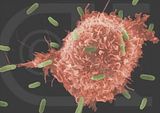
School:
Temasek Polytechnic
(Food Science & Nutrition)
Names
Alicia Chee(TA03)
Chin Ying(TA01)
Lynnette Heng(TA01)
Lorelle Ang(TA01)
Levina Tay(TA01)
Nicholas Tan(TA03)
Subject: PBPN
Topic:Immunology

Question 1
question 2
Question 2
question 3
Question 3
Question 3
Question 4
Question 4
Question 5
Question 5
Question 5


Bituwin,colorcodes - template
photobucket - image
Causation of Type I Diabetes Mellitus  Autoimmune response
Autoimmune response
Type 1 Diabetes, also known as Insulin-Dependent Diabetes Mellitus (IDDM) or Juvenile-onset diabetes. It is caused by the selective autoimmune destruction of the insulin-producing beta cells of the pancreas. Symptoms of disease are shown during childhood or adolescence and they rapidly progress to coma and death in the absence of treatment. Insulin is important for children's growth and development. Therefore, without insulin it may result in stunted growth. Type 1 diabetes usually occurs in individuals under 30 but it can occurs at any age.
In Type 1 diabetes patients, antibody and T-cell responses are made against insulin, glutamic acid decarboxylase and other specialized proteins of the pancreatic beta cell. It is not known which of these responses cause the disease. A healthy person has about 100 million beta cells, thus provides a greater insulin-making capacity than that needed by the body. The excess and the slow rate of beta cell destruction mean that the disease symptoms do not appear until years after the start of the autoimmune response. The disease starts to develop when there are insufficient beta cells to provide the sufficient amount of insulin to control the level of blood glucose.
The islets of Langerhans are scattered within the exocrine tissue of the pancreas. The pancreas contains about half a million islets, each consisting of a few hundred cells. Each islet cell is responsible to make a single hormone: alpha cells make glucagon, beta cells make insulin and delta cells make somatostatin.
Genetic factors
Researchers have found at least 18 genetic locations, that are related to type 1 diabetes. Each labeled IDDM1 - IDDM18. The IDDM1 region contains the HLA genes that affect the immune response. Advances in genetic research are continuing to identify other genetic components of type 1 diabetes.
However, most people who develop type 1 diabetes do not have a family history of the disease. The odds of inheriting the disease is only 10% if a first-degree relative has diabetes. Children are more likely to inherit the disease from a father with type 1 diabetes than from a mother with the disorder.Genetic factors cannot fully explain the development of diabetes.
Viruses
Recent research is providing evidence that the type 1 diabetes is caused due to an infection of the Coxsackie virus. It is a viral infection which attacks the intestinal tract, triggering the disease in genetically susceptible individuals.
How to control it?
People who develop type 1 diabetes need up to four injections of insulin daily for the rest of their life. The insulin is purified from the pancreata of pigs or cattle. However, as human and animal insulin have different amino acid sequences, some patients develop immune response to it. The antibodies they make causes negative effects when binded to insulin - it reduces activity of insulin and form soluble immune complexes causing further tissue damage and serum sickness. Patients who are unable to use animal insulin will have to use recombined human insulin produced in the laboratory from the cloned insulin gene.
There are many long-term complications – for example, type 1 diabetes is the major single cause of adult blindness and kidney disease and an important contributor to cardiovascular disease.
[Peter Parham. (2009). The Immune System. London & New York: Garland Science Publisher]
[Len Harrison. (n.d.). Autoimmunity: Type 1 Diabetes. Retrieved 5th Feb 2010, from Walter+Eliza Hall: Institute of Medical Research. Website: http://www.wehi.edu.au/faculty/disease_research/autoimmunity_research/]
[Wasdom01. (2009, August 01).Insulin Production and Type1 Diabetes (Etsuko Uno and Drew Berry, wehi, 2009). [Video File]. Retrieved from http://www.youtube.com/watch?v=MLM5418YPGc&feature=player_embedded]
[Harvey Simon. (2009). Diabetes Type 1 Causes. Retrieved 7th February 2010, from University of Maryland Medical Center. Website: http://www.umm.edu/patiented/articles/what_causes_type_1_diabetes_000009_2.htm]
1 Comments:
Very neat and easy to read, except for some parts where the font colour makes it hard to read. Otherwise, good job done.
By , at February 16, 2010 at 5:30 PM
